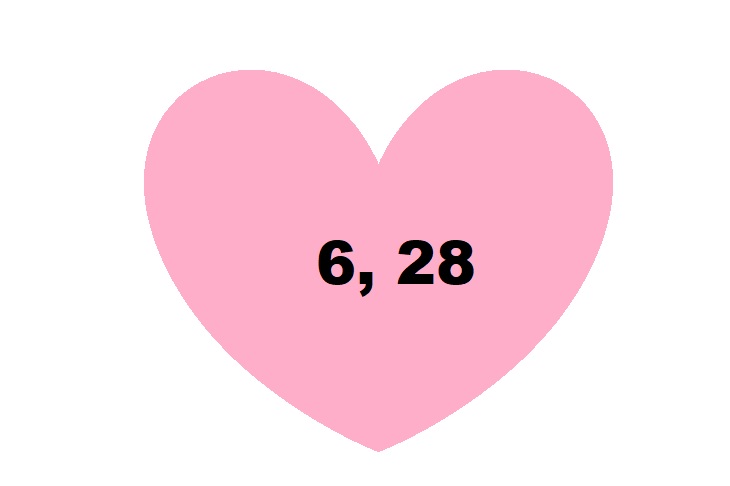How many roses or chocolates should you buy your loved one on Valentine’s Day? To a lot of people, numbers are hugely symbolic and buying your Valentine 13 Roses could easily send the wrong message. If your Valentine loves maths, then a Friendly Number could be your thing – the numerical equivalent of a stuffed bear holding a sparkly heart.
A note of caution – the opposite of a Friendly Number is known as a Solitary Number and these are probably best avoided with your Valentine. Even worse than this, there is an Undecided Category which contains numbers where nobody can currently prove whether they are Friendly or Solitary – you may as well just set your relationship status on Facebook to ‘It’s Complicated’.

What is a Friendly Number?
First let’s look at the Factors of a whole number. For the number 6, we could make it by multiplying 1×6, and 2×3 which means we can put the factors of 6 into a list: 1,2,3,6.
The Sum of the factors of 6 is: 1+2+3+6 = 12. This is the first thing we need to understand Friendly Numbers.
Abundancy
The Abundancy of a number is a mathematical calculation which works out the Sum of the Factors divided by the number itself.
So for the number 6 we can work out:
Definition of a Friendly Number
If a number has the same abundancy as another number, then it is a Friendly Number!
Number 6 is a friendly number because it has another friend in the form of the Number 28, they both have an Abundancy equal to 2.

This means that 6 and 28 are friendly with each other. The numbers 6 and 28 are also really special because they are Perfect Numbers – they are the sum of their proper factors e.g. 1+2+3=6 and 1+2+4+7+14=28. This means that 6 and 28 are friendly with all other Perfect Numbers, because every Perfect Number will have an abundancy equal to 2. Mathematicians have yet to prove whether the group of Perfect Numbers is infinitely big. Does 6 have an infinite number of friends – we don’t yet know!
Friendly Numbers under 100
If you want a Friendly number which is relatively small and therefore actually useful on Valentine’s day then take your pick from Friendly Numbers which are under 100. But you must be careful, because most of these numbers are not friendly with each other. For example, the abundancy of 6 is equal to 2, whereas the abundancy of 12 is equal to . The number 6 is a friendly number because it has friends – but it is certainly not friends with every other Friendly Number!
Friendly numbers under 100: 6, 12, 24, 28, 30, 40, 42, 56, 60, 66, 78, 80, 84, 96
And some of their friends…
It is quite remarkable that the smallest friend of the number 24 is so huge! It also looks as though 6 and 28 are the only Friendly Pair where both numbers are less than 100.
| Friendly Number | Smallest Friend |
| 6 | 28 |
| 12 | 234 |
| 24 | 91963648 |
| 28 | 6 |
| 30 | 140 |
| 40 | 224 |
| 60 | 1170 |
| 66 | 308 |
| 78 | 364 |
| 80 | 200 |
| 84 | 270 |
Solitary Numbers
We now turn our attention to Solitary Numbers. For many numbers there is an easy way to tell if they are Solitary. List the number itself and then the sum of its factors: [number itself, sum of its factors] – if the highest common factor of these two numbers is 1, then mathematicians have proved that this means the number is Solitary.
Take the number 4: [number itself, sum of its factors] gives us [4,1+2+4] which is [4,7], the highest common factor of 4 and 7 is 1, so this means that 4 is Solitary.
Unfortunately, this doesn’t work the other way round as there are some Solitary numbers which buck the trend. For example, the number 18 is Solitary and yet for 18 [number itself, sum of its factors] gives us [18,1+2+3+6+9+18] which is [18,39], the highest common factor of 18 and 39 is 3, and yet mathematicians have still proved that 18 is Solitary.
Numbers with an unknown status
The number 10 is the smallest number with an unknown status – mathematicians are unable to prove whether it is Solitary or Friendly. There are in fact lots of numbers with an unknown status, with 10,14,15 and 20 being the smallest examples. Mathematicians do believe that they are probably Solitary, but nobody is currently able to prove this.
Other unanswered questions
There are other exciting problems waiting to be solved, such as whether there is an infinite group of Friendly numbers with a common Abundancy. In other words, can a Friendly Number have an infinite number of Friends? At school it can feel like numbers are all sown up, and that we know everything there is to know, when in fact there are still many unanswered questions in mathematics. Have a happy mathematical Valentine’s Day everyone!
Image Credits
Featured Image by Laura Ockel on Unsplash
Can u leave by Patrick Perkins on Unsplash






